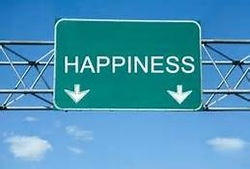
Most of us live at such a rapid pace because of the demands of others or because our own internal narrative is “on our case” non-stop or…both. Pace, whether real or imagined, can prevent us from experiencing the life we want. It, certainly, can keep us from enjoying today and compromise this desire we have to obtain, maintain and sustain a positive mood. To put it simply, it can compromise our desire to be happy.
 Click picture for more Happiness Articles
Click picture for more Happiness Articles It does not lie in our genetic “set point” as we discussed in our last article. These set points are “resistant to change, influence or control” according to psychologist, Sonja Lyubomirsky. (The How of Happiness)
Happiness does not lie in changing our circumstances. Why? We adapt to circumstances. They may give us an initial boost of morale but we readily adapt to our new and improved circumstances. We are not knocking moving to beautiful parts of the country or pay increases or getting healthier or losing weight but these “improvements” will only provide temporary increases in “happy”. So, you buy a new car and are thrilled with it. Two months later are you just as thrilled as when you bought it? Probably not. This phenomenon is called Hedonic Adaptation and it happens to all of us.
The Secret
Recall that 50% of our happiness is represented in a genetic set point. There is nothing we can really do about that. 10% of our happiness is affected by our circumstances. Since we have some influence here regarding our circumstances there is some marginal happiness improvement that can occur here. But, we adapt so there is not much opportunity here. 40% of our happiness is directly connected to intentional activity and what we do to build and sustain our positive mood and well-being.
When we study and observe genuinely happy people they do not just sit around being happy. They engage their world, seek new understandings, pursue creative achievements and…oh my goodness…control their thoughts and feelings. These are habits that can be learned.
There are three forces in the world that determine what you feel. These forces are called the Triad. Together, these three patterns create any—and every—emotional state.
Whatever you feel, you’re not feeling it because you have to feel it. You’re feeling it because you’ve chosen from the Triad. In order to master your emotions and consciously choose the emotions you want to live in, you need to understand these three forces and how to use them to your advantage.
#1: Physiology
Emotion is created by motion. Whatever you’re feeling right now is directly related to how you’re using your body. If you slump your shoulders and lean your head forward, you’ll move toward a state of depression. However, the next time you find yourself in a negative state, stand up, throw your shoulders back and take a few deep breaths. You’ll find that you’re able to put yourself in a resourceful state. From this state, you can make stronger decisions and enjoy a sense of certainty that will keep you calm in the face of uncertainty.
#2: Language
Language comes in many forms, one of which includes the questions you ask yourself, either aloud or inside your head. If you ask, “Why does this always have to happen to me?” you’ll create a much different set of emotions than if you asked, “How can I benefit from this?” or “Where’s the gift in this?” or “What’s humorous about this?”
The language patterns you run play a significant role in the meaning you give a situation—and the emotion that situation creates in you. When you feel negative emotions taking over, look at the language surrounding your situation. How can you shift it to create a more empowering state?
#3: Focus
Where focus goes, energy flows. And where energy flows, whatever you’re focusing on grows. In other words, your life is controlled by what you focus on. That’s why you need to focus on where you want to go, not on what you fear. When you next find yourself in a state of uncertainty, resist your fear. Shift your focus toward where you want to go and your actions will take you in that direction.
Understanding—and influencing—your Triad is the first step toward emotional mastery. When you can influence your emotions using the Triad, you can choose to spend more time in positive, resourceful emotional states. From these states, you’ll make the decisions that will help you reach your highest pntial and enjoy your life in every moment.
 RSS Feed
RSS Feed